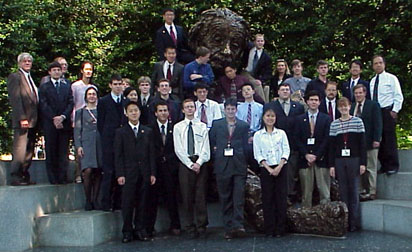By Richard M. Todaro
 The 2001 US Physics Team and their coaches gather in front of the National Academy in the friendly shadow of Albert Einstein. |
The five high school students who will represent the United States at the 32nd annual International Physics Olympiad in Turkey this summer have been selected from among the two dozen students who completed a grueling one-week "physics boot camp" at the University of Maryland in College Park, MD.
These five students and one alternate were chosen from a group of 24 that "includes some of the brightest and most talented physics and mathematics students in the country," according to Dr. Bernard Khoury, the executive director of the American Association of Physics Teachers, (AAPT) the organization that oversees selection of the boot camp participants and the final five team members. The program also benefits from fundraising and promotional activities of the American Institute of Physics (AIP), and receives financial support from APS.
The five students are Brian Beck of Beachwood, Ohio, Andrew M. Lutomirski of Los Angeles, California, Vladimir S. Novakovski of Springfield, Virginia, Daniel J. Peng of Colts Neck, New Jersey, and Willie W. Wong of Short Hills, New Jersey. The alternate is Ryan J. Hendrickson of Davidsonville, Maryland.
The selection over the Memorial Day weekend marked the end of the intense one-week program of exams, lectures and group laboratory work with the final team of travelers to the international event chosen by Khoury and seven coaches led by Dr. Mary Mogge.
The 20 male and 4 female students who participated in the annual boot camp this past May represented the highest scoring students on a battery of tests and were winnowed down from a nationwide field of nearly 1,100.
The students were required to spend "five to eight hours a day doing nothing but" physics problem solving, Khoury said. After hours, the students got to tour the NASA Goddard Space Flight Center in Greenbelt, Maryland and met with various members of Congress on a field trip to nearby Washington, D.C.
Mogge, the US Physics Team academic director since 1999 and one of the seven coaches since 1995, said the final decision is based partly exam results and partly on lab skills. She said this reflects the "theoretical" and the "practical" components of the international competition, where team members vie for gold, silver and bronze medals.
"In the international competition, 40 percent of the score for a medal is determined by labs or the practical part and 60 percent by the theoretical part," said Mogge, who is also a professor of physics at California State Polytechnic University in Pomona.
The chosen five students will travel to Antalya, Turkey where they will represent the United States at the competition, which runs from June 28 to July 6, 2001. About 60 nations participate in the event pitting the best and the brightest physics students from around the world against each other.
Although the competition has been held every year since 1967, originally it included only Soviet-bloc nations and the US did not participate until 1986. Since that time, the AAPT has organized the US team through a selection process that starts in early January when high school teachers from around the country nominate their highest-achieving students to take a national exam.
The only requirement for participation in any given year is that students be in high school and that they have not reached their 19th birthday by June 1. Students may participate in more than one year and some students have won medals in multiple years.
The high school requirement is necessary because "some of these students are so bright that they could be in college by age 17," according to Maria Elena Khoury, the director of AAPT's programs and conferences.
She said that as many as 8,000 tests are mailed out nationwide to all 50 states and the District of Columbia to high school physics teachers in early January seeking nominations for students to take the test. She said there are usually about 1,100 responses and from these the top 200 scorers are selected in the first round and the final 24 who attend the physics boot camp are selected in the second round.
This year's 24 students are from 16 states, including three each from Illinois, California, and New Jersey and two from Virginia. Most of the two dozen boot camp attendees have attended schools with Advanced Placement physics and mathematics programs.
Mogge said the boot camp program gives the students "a chance to meet people who feel the same way about physics as they do." She also said that many of the students end up at Harvard, MIT, and Caltech and that "almost all go to prestigious schools," whether liberal arts colleges or state universities.
©1995 - 2024, AMERICAN PHYSICAL SOCIETY
APS encourages the redistribution of the materials included in this newspaper provided that attribution to the source is noted and the materials are not truncated or changed.
Associate Editor: Jennifer Ouellette
July 2001 (Volume 10, Number 7)
Articles in this Issue

